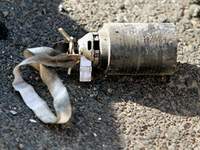"He was picking grapes when he died," says Khalil Kassem Terkiya, glancing at his wife as he recalls the day their son was killed by a cluster bomb in southern Lebanon.
Graying and slight, Terkiya looks older than his 46 years: "A cluster bomb was caught in the vine and it exploded. It was the day after the war finished. He was 19."
His wife walks away without speaking, her head bowed. The couple's son, Ali, was one of the first post-war victims of the estimated one million cluster bombs fired by Israel into southern Lebanon during a month-long conflict with Hezbollah in 2006.
Because so many of them failed to detonate on impact, Ali was not to be the last victim.
Since the end of the war, more than 350 people in Lebanon have been killed or injured by unexploded cluster bombs acting as de facto land mines, and every month that figure slowly increases.
Terkiya lives in the village of West Zawtar, at the heart of a swathe of land south of the town of Nabatiyeh that was badly hit during the war.
Large areas of southern Lebanon became a no-go area as a result of the cluster bomb-strikes; farmers were cut off from their land and schools forced to close their playgrounds.
'Yesterday's war'
While more than half of this land has now been declared safe, de-mining progress is stalling.
The crucial donations that pay for cluster bomb clearance are drying up as new crises deflect attention away from what has become "yesterday's war" and the global recession puts pressure on foreign aid budgets.
The result has been a dramatic cut in de-mining capacity in the country.
"In 2007 there were 114 clearance teams working here," says Lt Col Mohamed el Cheikh of the Lebanese Mine Action Centre (LMAC), a military body set up to co-ordinate the clearance with the various civilian de-mining agencies that work in the country.
At current capacity, LMAC estimates that it will take at least another three-and-a-half years to finish the job, although that time could be cut to just 18 months if new donations are made.
Danish Church Aid (DCA), one of the clearance agencies working in Lebanon, predicted earlier this month that the delay would lead to "many more" civilian casualties.
As clearance organizations pack up their equipment and pull out, LMAC is expanding its efforts to educate the civilian population, particularly children, about the risks posed by the deadly devices.
Officials say mine risk education and bomb-clearance go hand in hand- they are the two most essential components of efforts to avoid further casualties. But with clearance work faltering, the education programs have taken on a new significance; people are going to have to live the bombs for longer than they thought.
"Since we don't have enough money for clearance, we have to increase the mine risk education campaigns," Cheikh says. "It's logical. We have to keep reminding people of the danger - particularly children."
Children at risk
Almost a third of the post-war cluster bomb casualties have been under the age of 18.
Children are particularly at risk, experts say, because they often play in remote areas and are curious about strange objects they come across. In August alone, six children were hurt in cluster bomb explosions in Lebanon, according to DCA.
The mine-risk education program has been devised to maximize children's exposure to mine safety messages while providing incentives for them to pay attention.
Soldiers give presentations in community halls and schools across southern villages, distributing school bags and stationery emblazoned with the "golden rules" for dealing with unexploded ordnance: "Don't approach, don't touch, telephone immediately."
For younger children there are coloring books with cluster bombs in the pictures, stickers featuring their favorite cartoon characters warning them to take care and even a game based on Monopoly, all aimed at driving home safety messages.
The gifts are popular with children in the south.
Soldiers educate children
In Yohmor, a small village perched on a hillside near Beaufort Castle, they seem to be educating as well as entertaining.
"I've never seen a cluster bomb," says eight-year-old Aya, as she watches a soldier carrying a display case filled with inert explosives in preparation for an education session.
"If I did, I wouldn't touch it. I would tell my parents about it."
She is clutching a copy of the coloring book. Other children are busy swapping stickers. At the back of the room, parents look on as the soldiers prepare to distribute more stationary items, drawing names out of a basket to see who gets what. There are not enough supplies for everyone.
"These are poor people," Cheikh explains. "If you give the children school bags and pencil cases, it saves the family money and it spreads the message to the children."
This month more than 10,000 children from southern Lebanon will have attended LMAC's mine-awareness presentations and the program is to be expanded in coming years, as the Lebanese army look to take on more dedicated de-mining staff.
Back in West Zawtar, Khalil Terkiya looks on as the hall fills up with chattering children who have come to the village's LMAC presentation.
He believes the education sessions are important, but he knows the only way the children will be truly safe is if the cluster bombs are cleared.
"The olive groves here are still polluted with cluster-bombs," he says. "They are still a threat to all of us."
Andrew Wander, a media fellow with legal charity Reprieve, works on Al Jazeera's Public Liberties and Human Rights Desk.
PHOTO CAPTION
A cluster bomb
Source: Al-Jazeera


 Home
Home Discover Islam
Discover Islam Quran Recitations
Quran Recitations Lectures
Lectures
 Fatwa
Fatwa Articles
Articles Fiqh
Fiqh E-Books
E-Books Boys & Girls
Boys & Girls  Ramadan
Ramadan Fatwa Audios
Fatwa Audios Month of Mercy
Month of Mercy Women
Women Eed Al- Fitr
Eed Al- Fitr Food Recipes
Food Recipes Videos
Videos

 Prayer Times
Prayer Times












